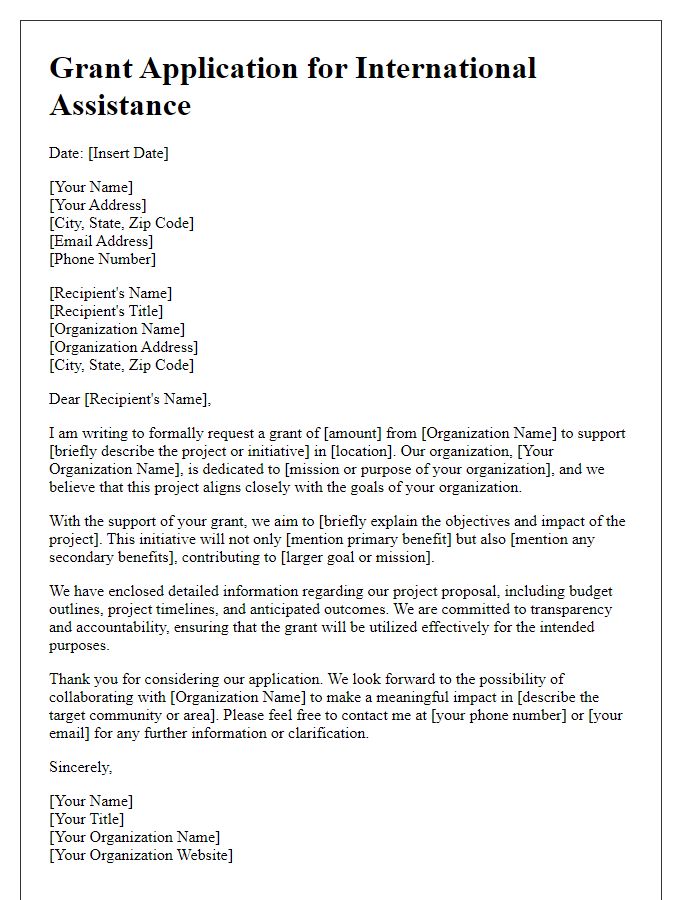Are you looking to craft a compelling letter for your foreign aid proposal? Writing an effective proposal can make all the difference in securing the support you need for your project. With the right approach, you can convey your mission and the impact of your work in a way that resonates with potential donors. Ready to dive deeper into the art of proposal writing? Let's explore the key elements together!

Clear project description
A clear project description outlines the goals and objectives of the initiative, defining key aspects such as target population and geographic region. For example, a project aimed at improving educational access in rural regions of Sub-Saharan Africa might target children aged 6 to 12. The initiative plans to establish community learning centers equipped with essential resources such as textbooks and digital learning tools. Project timelines indicate a three-year implementation phase with expected outcomes, including a 30% increase in literacy rates. Additionally, collaboration with local governments and non-governmental organizations (NGOs) will be emphasized, highlighting the importance of community involvement and sustainable practices. Ultimately, the project aims to empower a generation through education, contributing to long-term societal development.
Specific goals and objectives
Specific goals and objectives are crucial components of foreign aid proposals aimed at sustainable development in targeted regions. These goals often include reducing poverty rates, improving access to education, enhancing healthcare systems, and promoting gender equality in communities, particularly in developing countries like Tanzania or Bangladesh. For instance, a specific goal might be to increase literacy rates by 20% among women aged 15-24 within three years through targeted educational programs and workshops. Objectives could specify the implementation of one new community educational center per district, providing scholarships for 500 female students, and training 50 local educators in innovative teaching methods. Additionally, integrating health services, such as maternal and child health initiatives within the educational framework, can promote holistic development, ensuring that economic growth aligns with social improvements.
Detailed budget outline
Creating a detailed budget outline for foreign aid proposals involves several key components critical for financial accountability and clarity. This includes categories such as personnel costs, which encompass salaries and benefits for local staff engaged in project implementation, often reflecting the average wage rates in the host country. Additionally, direct project expenses, like materials and supplies necessary for community workshops or healthcare services, must be accurately estimated, ensuring alignment with local market prices. Administrative costs, often capped at 10% of the total budget, cover overheads for office space, utilities, and communication, vital for maintaining operational efficiency. Furthermore, travel expenses for project monitoring, including airfare and accommodation for visiting team members, should be meticulously detailed. Lastly, evaluations and reporting budgets, which account for third-party assessments to ensure compliance with donor requirements, enhance the proposal's credibility and transparency.
Impact assessment and measurement
Impact assessments evaluate the effectiveness of foreign aid initiatives such as educational programs, healthcare services, and infrastructure projects. These assessments identify key performance indicators (KPIs) like enrollment rates (measured as a percentage increase), recovery rates in health outcomes (tracked by the World Health Organization standards), and infrastructure utility levels (assessed via user satisfaction surveys). Measurement methodologies can include quantitative surveys, qualitative interviews, and longitudinal studies (lasting several years). Stakeholders, including local governments and non-profit organizations in regions such as Sub-Saharan Africa or Southeast Asia, often partner to ensure accurate data collection and analysis. Timely reporting of findings (often quarterly or annually) supplies essential feedback, facilitating adjustments to maximize the impact of aid initiatives.
Stakeholder involvement and collaboration strategy
The implementation of effective foreign aid proposals relies on robust stakeholder involvement and collaboration strategies. Engaging local communities (such as farmers in rural regions or urban youth groups) fosters trust and ensures that aid initiatives address specific needs. Involving governmental bodies at various levels (national, regional, local) ensures alignment with policy frameworks and maximizes resource utilization. Partnerships with non-governmental organizations (NGOs) and international organizations, such as the United Nations or World Bank, enhance expertise and access to additional funding. Regular stakeholder meetings (quarterly or bi-annually) and feedback mechanisms create avenues for transparent communication and continuous improvement of aid strategies. Training workshops focused on capacity building empower local populations to participate actively and sustain project outcomes long after foreign aid concludes. Effective collaboration leverages the strengths of each stakeholder, promoting an inclusive approach to problem-solving and resource allocation.
Letter Template For Foreign Aid Proposals Samples
Letter template of funding request for cross-border development projects

Letter template of support request for international educational projects












Comments